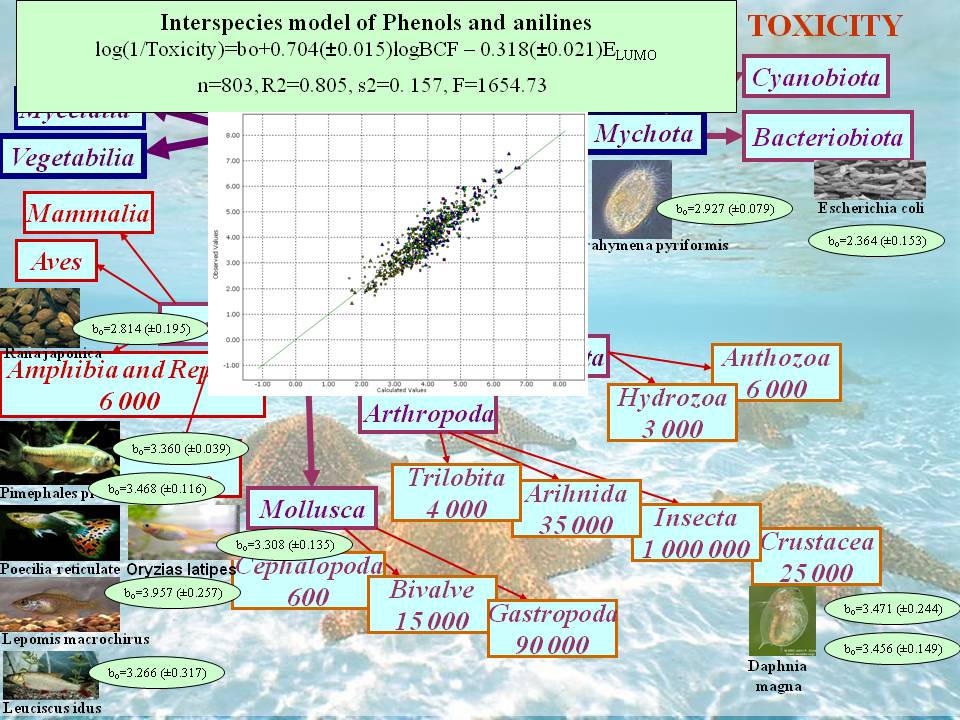Pimephales promelas LC50 96h
Endpoint
The acute aquatic toxicity model predicts the concentration of chemicals that kill 50% (LC50) of the test fish Pimephales promelas (Fathead minnow) within a designated period.
Data
The training set consists of LC50 values for 628 chemicals [1-6]:
- Test duration - 96 hours,
- Test species - Pimephales promelas (Fathead minnow).
The tested chemicals belong to the following categories:
- Narcotic toxicants - 221 chemicals,
- Phenols and anilines - 93 chemicals,
- Narcotic amines - 55 chemicals,
- Esters - 26 chemicals,
- Aldehydes - 46 chemicals,
- α, β- unsaturated alcohols - 9 chemicals,
- Reactive unspecified chemicals - 151 chemicals.
Model
The organism response to the presence of toxicant in the environment is considered as a consequence of the combined influence of two different processes: uptake of the chemical into the biophase and interaction with the site of action [7]. In the present model, the uptake is modeled by maximum potential of the toxicant to bioconcentrate in the fish, while the interaction of chemicals is explained by descriptors assessing the electrophilic character of the molecule [8]. Such descriptors could include the energy of the lowest unoccupied molecular orbital, electronegativity, average or maximum superdelocalizability, maximum charge at non-hydrogen atom, etc. The following models were developed based on regression analysis of the data:
Narcotic toxicants
log 1/LC50 = 1.66(±0.07)+1.09(±0.03) logBCFmax -0.18(±0.02)ELUMO
Phenols and anilines
log 1/LC50 = 2.25(±0.10)+0.97(±0.04) logBCFmax -0.23(±0.06)ELUMO
Narcotic amines
log 1/LC50 = 2.28(±0.08)+0.89(±0.05) logBCFmax
Esters
log 1/LC50 = 2.51(±0.21)+0.87(±0.10) logBCFmax -0.20(±0.09)ELUMO
Aldehydes
log 1/LC50 = 0.47(±2.11)+0.69(±0.09) logBCFmax +9.01(±7.08)ELUMO
α, β- Unsaturated alcohols
log 1/LC50 = 4.22(±0.25)+0.58(±0.23) logBCFmax -24.78(±12.11)ELUMO
where BCFMax is the maximum bioconcentration factor [9], ELUMO is the energy of the lowest unoccupied molecular orbital, ODDI is the donor delocalizability of the aldehyde O-atom and QC is the charge of the C atom from α, β- unsaturated alcohols. For the reactive unspecified chemicals only the minimum toxicity is determined by the model for narcotic chemicals ( log 1/EC50 ≥ log 1/EC50 of narcotics).
Domain
The stepwise approach [10] was used to define the applicability domain of the model. It consists of the following sub-domain levels:
- General parametric requirements - includes ranges of variation of log KOW and MW,
- Structural domain - based on atom-centered fragments (ACFs).
A chemical is considered In Domain if its log KOW and MW are within the specified ranges and its ACFs are presented in the training chemicals. The information implemented in the applicability domain is extracted from the correctly predicted training chemicals used to build the model and in this respect the applicability domain determines practically the interpolation space of the model.
Statistics
The precision of the regression models is characterized by the following estimates - the 95% confidence intervals of model parameters, coefficient of determination (R2), mean squared error (estimate of error variance, s2), F value:
Narcotic toxicants
- Coefficient of determination R2 = 0.89,
- Mean squared error (estimate of error variance) s2 = 0.19,
- F value = 869,
- Number of chemicals, n = 221.
Phenols and anilines
- Coefficient of determination R2 = 0.86,
- Mean squared error (estimate of error variance) s2 = 0.16,
- F value = 270,
- Number of chemicals, n = 93.
Narcotic amines
- Coefficient of determination R2 = 0.86,
- Mean squared error (estimate of error variance) s2 = 0.25,
- F value = 322,
- Number of chemicals, n = 55.
Esters
- Coefficient of determination R2 = 0.79,
- Mean squared error (estimate of error variance) s2 = 0.22,
- F value = 44,
- Number of chemicals, n = 26.
Aldehydes
- Coefficient of determination R2 = 0.60,
- Mean squared error (estimate of error variance) s2 = 0.23,
- F value = 32,
- Number of chemicals, n = 46.
α, β- Unsaturated alcohols
- Coefficient of determination R2 = 0.59,
- Mean squared error (estimate of error variance) s2 = 0.38,
- F value = 4.3,
- Number of chemicals, n = 9.
References
1. DL. Geiger, LT. Brooke, DJ. Call. Acute toxicities of organic
chemicals to fahhead minnows, vol 5. University of wisconsin-
superior, WI, USA, p 332, (1990)
2. DL. Geiger, CE. Northcott, DJ. Call, LT. Brooke. Acute
toxicities of organic chemicals to fahhead minnows, vol 2.
University of wisconsin- superior, WI, USA, p 326, (1985)
3. LT. Brooke, DJ. Call, DL. Geiger, CE. Northcott. Acute
toxicities of organic chemicals to fahhead minnows, vol 1.
University of wisconsin- superior, WI, USA, p 414, (1984)
4. VR. Mattson, JW. Arthur, CT. Walbridge. Acute toxicity of
selected organic compounds to fathead minnows. EPA-600/3-76-097.
U.S. Environmental protection agency, duluth, mn, (1976)
5. DL. Geiger, SH. Poirier, LT. Brooke, DJ. Call. Acute toxicities
of organic chemicals to fahhead minnows, vol 4. University of
wisconsin- superior, WI, USA, p 354, (1988)
6. DL. Geiger, SH. Poirier, LT. Brooke, DJ. Call. Acute toxicities
of organic chemicals to fahhead minnows, vol 3. University of
wisconsin- superior, WI, USA, p 328, (1986)
7. J.W. McFarland, J. Med. Chem. 13 (1970) 1092-1196.
8. S.D. Dimitrov, O.G. Mekenyan, G.D. Sinks, T.W. Schultz, Journal
of Molecular Structure (Theochem, 622 (2003) 63-70.
9. S. Dimitrov, N. Dimitrova, D. Georgieva, K. Vasilev, T.
Hatfield, J. Straka, O. Mekenyan, SAR and QSAR in Environmental
Research, 23 (2012) 17-36.
10. S. Dimitrov, G. Dimitrova, T. Pavlov, N. Dimitrova, G.
Patlevisz, J. Niemela and O. Mekenyan, J. Chem. Inf. Model. 45
(2005) 839-849.



